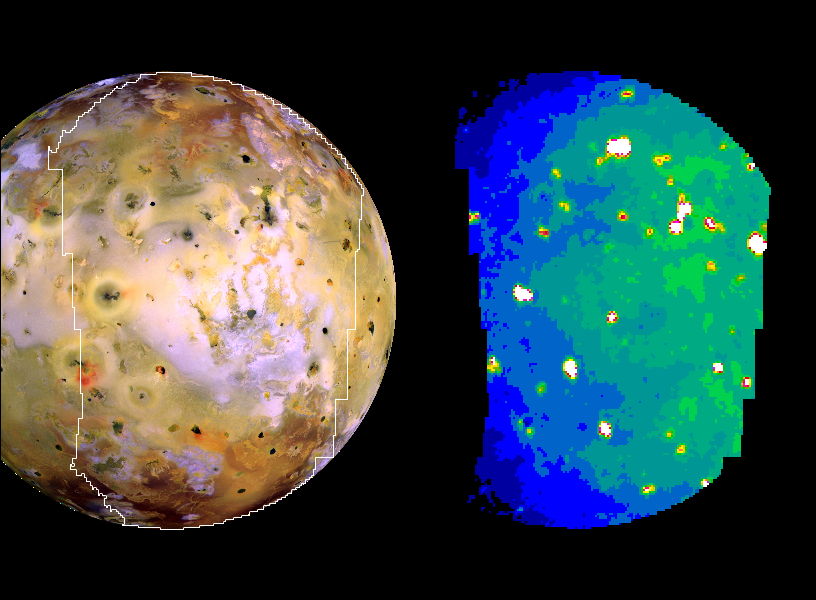Volcanic Eruptions on Jupiter's 'Pizza Moon' Io Spotted from Earth

A team of SETI astronomers have proved it's possible to see volcanic eruptions on Io — a moon of Jupiter — from our perch on Earth hundreds of millions of miles away.
Based on 44 nights of telescope observations, the group from the SETI Institute's Carl Sagan Center showed it is possible to see fiery volcanoes spewing on Io (which is also known as Jupiter's "Pizza Moon" for that reason). They can see features as small as 62 miles (100 kilometers) across using a particular telescope technique.
This means we don't necessarily need a spacecraft to watch over Io's volcanoes. That's an important finding considering there won't be another long-term mission at Jupiter until the 2030s, said SETI's Franck Marchis, who led the team.
"We are not going to have a (Jupiter) space mission for several years," said Marchis, the senior planetary astronomer of the Carl Sagan Center. [Amazing Photos: Jupiter's Volcanic Moon Io]
"If we want to continue to invest time in observing volcanic activity, we need to focus on ground-based telescopes. It's not a community that has been used to it ... our goal is really to motivate them to think about it."
Bending Io's light
Marchis and his team used a technique called adaptive optics. It's a technology that helps smooth out blurs that conventional telescopes see when trying to take pictures through the turbulent atmosphere of Earth.
Get the world’s most fascinating discoveries delivered straight to your inbox.
A telescope, fitted with a distortable mirror, is hooked up to the adaptive optics system. As the light bends in the atmosphere, a sensor measures the distortions with the assistance of a computer, which makes calculations.
The best systems today can make 1,000 calculations per second, Marchis said, and that figure is improving all the time.
As the number of calculations increase, so does the accuracy. It makes the image look sharper. In Marchis' case, it allowed his team to track the Tvashtar volcano's eruption in 2006-7 at the same time as the New Horizons spacecraft saw it. (New Horizons is en route to Plutoand will arrive in 2015.)
Io isn't the only astronomical target that benefits from adaptive optics. The system has also been used to find planets around distant stars, to image cracks on Europa, and to give a more precise look at Jupiter's atmosphere.
As the resolution improves, Marchis said we'll one day be able to peer at the moons of exoplanets in search of volcano flares and other large phenomena.
"The thermal eruption of these moons may be so strong that we may be able to see them directly with instruments," he said.
An explosive mystery
Io's volcanic processes are poorly understood because we don't have long-term continual observations of the moon, Marchis said. Even when the Galileo spacecraftorbited Jupiter and its moons between 1995 and 2003, it only had brief spells at Io due to the intense, electronics-baking radiation surrounding the moon.
A long-term observation program of Io could solve a mystery that has been puzzling Marchis' team. Io has been unusually quiet in the past two years, and astronomers aren't sure why.
In 13 nights of observation since June 2010, Marchis' team has observed none of the outburst eruptions that characterized the moon in incidents in 2001 and 2007.
Marchis speculated Io might have a long-term cycle of intense volcanic explosions over several years, but more observations are needed, he said.
He speculated Io's volcanoes may need time to refill their chambers in between large outbursts, but he added there is no known process that scientists can correlate with Io's volcanic activity.
Giant telescopes will improve resolution
Marchis' team used three large telescopes (8 to 10 meters in diameter) to watch over Io during the past eight years: W.M. Keck II and Gemini North at Mauna Kea, Hawaii, and Chile's Very Large Telescope No. 4 (also known as Yepun).
He estimates there are about seven telescopes in the world that can do the same kind of searches today, but there are more telescopes under construction that will make the technology even better.
The main telescope Marchis awaits is the planned $1.3 billion Thirty Meter Telescope. When the giant telescope is ready in 2021, the images it will produce will be just 22 miles (35 kilometers) in resolution — the same resolution as Galileo, Marchis said.
"The point is to mobilize the Io community, because we have been kind of dormant due to the fact there has been no space mission."
This story was provided by SPACE.com, a sister site to LiveScience. Follow Elizabeth Howell @howellspace, or SPACE.com @Spacedotcom. We're also on Facebook and Google+

Elizabeth Howell was staff reporter at Space.com between 2022 and 2024 and a regular contributor to Live Science and Space.com between 2012 and 2022. Elizabeth's reporting includes multiple exclusives with the White House, speaking several times with the International Space Station, witnessing five human spaceflight launches on two continents, flying parabolic, working inside a spacesuit, and participating in a simulated Mars mission. Her latest book, "Why Am I Taller?" (ECW Press, 2022) is co-written with astronaut Dave Williams.



![Quiescent activity of Io observed in 2010 & 2011 showing the several quasi-permanent eruptions in Lp band (at ~3μm) [bottom] and the absence of bright outbursts or young eruptions in K band (at ~2 μm) [top].](https://cdn.mos.cms.futurecdn.net/HpjKFUP5VDMFmL9WFqpHUi.jpg)


